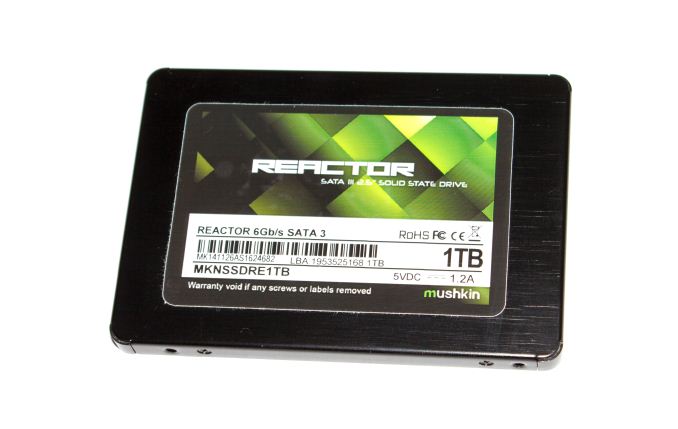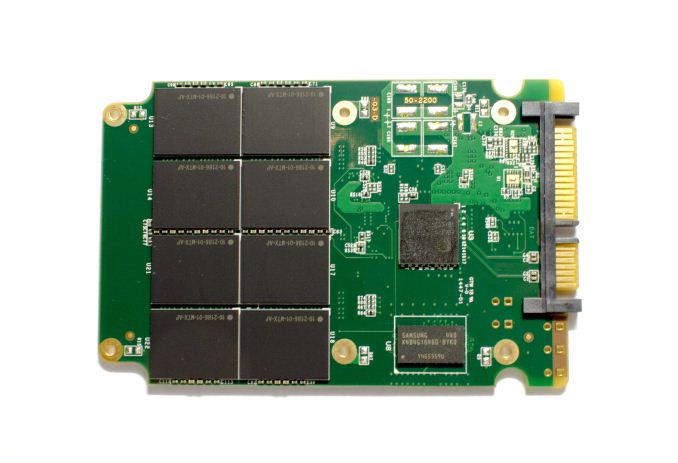Mushkin Reactor 1TB SSD Review
by Kristian Vättö on February 9, 2015 11:32 AM EST- Posted in
- Storage
- SSDs
- Mushkin
- Silicon Motion
- SM2246EN
- Reactor
- Micron 16nm

Silicon Motion has practically become the new SandForce. Almost every tier three manufacturer (i.e. one with no controller/firmware IP or NAND fab) has released an SM2246EN based drive in the past ten months and recently Silicon Motion scored two major tier one partners (namely Micron/Crucial and SanDisk) as well. To be honest, this hasn't come as a surprise because the SM2246EN is a really solid controller with good performance and more importantly it's been mostly issue free (which is something that cannot be said about SandForce).
Mushkin's Reactor combines the SM2246EN with Micron's latest 128Gbit 16nm MLC NAND, and this is actually the first time I've encountered a non-Micron/Crucial SSD with Micron's 16nm NAND. That really emphasizes the benefit NAND manufacturers have because Micron has been using 16nm NAND in its own SSDs for over six months now, but the company hasn't begun shipping it to others in volume until now. I suspect the volumes are still fairly low because the Reactor only comes in 1TB capacity, which is still fairly expensive and thus limits the demand to a level that is easier to manage compared to the more popular 256GB and 512GB models. I was told that 256GB and 512GB models may follow later, but as of now Mushkin will only be offering the Reactor in 1TB.
| Mushkin Reactor Specifications | |
| Capacity | 1TB |
| Controller | Silicon Motion SM2246EN |
| NAND | Micron 128Gbit 16nm MLC |
| Sequential Read | 560MB/s |
| Sequential Write | 460MB/s |
| 4KB Random Read | 74K IOPS |
| 4KB Random Write | 76K IOPS |
| Encryption | N/A |
| Endurance | 144TB |
| Warranty | Three years |
In terms of features the Reactor is a fairly typical value drive without any special features. Neither hardware accelerated encryption nor DevSleep is supported, although the Reactor does support slumber power states for low idle power consumption. Endurance is a respectable 144TB, which translates to 131GB of writes per day for three years.
Moreover, the retail package doesn't include anything in addition to the drive itself and Mushkin offers no software/toolbox for its SSDs.
There are sixteen NAND packages on the PCB with eight on each side. Since we are dealing with a 128Gbit (16GB) die, that translates to four dies per package. Mushkin actually does the packaging in-house (i.e. buys NAND in wafers and then does the binning and packaging), which is why the packages lack the typical Micron logo and labels.
Test Systems
For AnandTech Storage Benches, performance consistency, random and sequential performance, performance vs. transfer size, and load power consumption we use the following system:
| CPU | Intel Core i5-2500K running at 3.3GHz (Turbo & EIST enabled) |
| Motherboard | ASRock Z68 Pro3 |
| Chipset | Intel Z68 |
| Chipset Drivers | Intel 9.1.1.1015 + Intel RST 10.2 |
| Memory | G.Skill RipjawsX DDR3-1600 4 x 8GB (9-9-9-24) |
| Video Card | Palit GeForce GTX 770 JetStream 2GB GDDR5 (1150MHz core clock; 3505MHz GDDR5 effective) |
| Video Drivers | NVIDIA GeForce 332.21 WHQL |
| Desktop Resolution | 1920 x 1080 |
| OS | Windows 7 x64 |
Thanks to G.Skill for the RipjawsX 32GB DDR3 DRAM kit
For slumber power testing we used a different system:
| CPU | Intel Core i7-4770K running at 3.3GHz (Turbo & EIST enabled, C-states disabled) |
| Motherboard | ASUS Z87 Deluxe (BIOS 1707) |
| Chipset | Intel Z87 |
| Chipset Drivers | Intel 9.4.0.1026 + Intel RST 12.9 |
| Memory | Corsair Vengeance DDR3-1866 2x8GB (9-10-9-27 2T) |
| Graphics | Intel HD Graphics 4600 |
| Graphics Drivers | 15.33.8.64.3345 |
| Desktop Resolution | 1920 x 1080 |
| OS | Windows 7 x64 |
- Thanks to Intel for the Core i7-4770K CPU
- Thanks to ASUS for the Z87 Deluxe motherboard
- Thanks to Corsair for the Vengeance 16GB DDR3-1866 DRAM kit, RM750 power supply, Hydro H60 CPU cooler and Carbide 330R case











69 Comments
View All Comments
Hulk - Monday, February 9, 2015 - link
When it's written as 131GB writes/day for 3 years it seems like more than enough.But cell endurance of 144 writes seems really, really low.
hojnikb - Monday, February 9, 2015 - link
It doesnt work like that. 144TB for 1TB doesn't translate to 144 p/e flash. You have to factor in write amplification, which can be more than 1 on controller like this.Also conservative rating is nothing new with budget driver.
cm2187 - Friday, February 13, 2015 - link
Stupid question: has anyone any experience with SSD reliability over time. I.e. is it reliable to store static data 3-5y+? Or does the 3y (or 5y) guarantee also means the data should be migrated out after that period even if the number of writes has been low?hojnikb - Monday, February 9, 2015 - link
Its just a conservative rating for warranty purposes. Besides, other value drives are no better at this (evo is only "good" for 150TB).In reality, drives typically last many times the rated endurance.
DanNeely - Monday, February 9, 2015 - link
More importantly, it's set low to scare off enterprise customers who'd subject the drive to an order of magnitude more IO.toyotabedzrock - Monday, February 9, 2015 - link
So if the endurance is 144TB on a 1TB drive, they are predicting the nand can only take 144 writes?That is a bit scary for even home use. I wouldn't trust my data to that.
zepi - Monday, February 9, 2015 - link
There is not a single medium or drive out there that you should trust your data on. Only thing you can trust is redundancy.hojnikb - Monday, February 9, 2015 - link
No. Read my post above ^^TheinsanegamerN - Monday, February 9, 2015 - link
the 512GB crusial mx 100 endurance is only 72TB, yet people dont seem to be complaining. besides, as typical day to day use only accounts for maybe ~10GB or writes(3.65TB a year), the 144TB endurance will last far longer than the machine it is put in.Murloc - Monday, February 9, 2015 - link
yeah problem is that until it's broken, I'll keep moving it on to the next machine.But I write about 1 GB/week to the SSD so I should be safe, unless windows does a lot of that in the background, I don't know, I just deactivated all the bad stuff I read about.